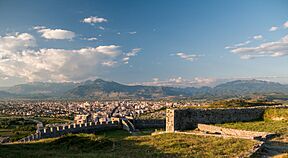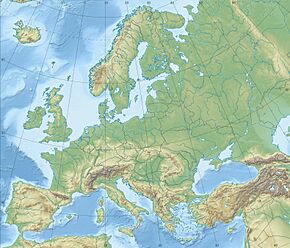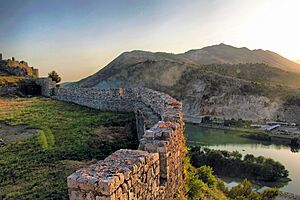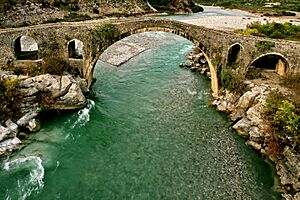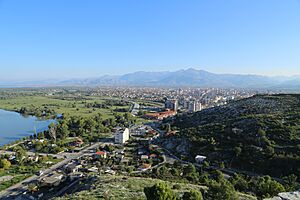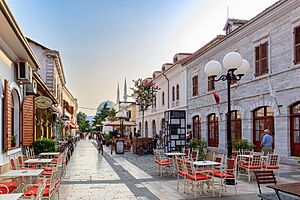Shkodër facts for kids
Quick facts for kids
Shkodër
|
|||
|---|---|---|---|
|
Municipality and city
|
|||
|
View of Shkodër
Ebu Beker Mosque
Kolë Idromeno Street
Rozafa Castle
Franciscan Church from Kolë Idromeno Street
Drin Delta
Lake of Shkoder with the Albanian Alps
|
|||
|
|||
| Country | Albania | ||
| Region | Northern Albania | ||
| County | Shkodër | ||
| Founded | 4th century BCE | ||
| Government | |||
| • Type | Mayor–council | ||
| • Body | Shkodër Municipal Council | ||
| Area | |||
| • Municipality | 872.71 km2 (336.96 sq mi) | ||
| • Administrative unit | 16.46 km2 (6.36 sq mi) | ||
| Elevation | 13 m (43 ft) | ||
| Population
(2011)
|
|||
| • Municipality | 135,612 | ||
| • Municipality density | 155.39/km2 (402.5/sq mi) | ||
| • Unit | 77,075 | ||
| Demonym(s) | Albanian: Shkodran (m), Shkodrane (f) | ||
| Time zone | UTC+1 (CET) | ||
| • Summer (DST) | UTC+2 (CEST) | ||
| Postal code(s) |
4000-4017
|
||
| Area code(s) | +355 (0) 22 | ||
| Vehicle registration | SH | ||
Shkodër is the fifth-largest city in Albania. It is the main city of Shkodër County and the Shkodër Municipality. People have lived in Shkodër for a very long time, since the Early Bronze Age (around 2250–2000 BCE). The city has about 2,200 years of recorded history.
Shkodër is located on the Plain of Mbishkodra. It sits between the southern part of Lake Shkodër and the Albanian Alps. The city is also on the banks of the Buna, Drin, and Kir rivers. Because it is close to the Adriatic Sea, Shkodër has a Mediterranean climate with some continental weather influences.
An ancient settlement called Skodra was started by the Illyrian tribe of Labeatae in the 4th century BCE. It became the capital of the Illyrian kingdom. The Romans took over the city in 168 BCE. In the 3rd century CE, Shkodër became the capital of a Roman area called Praevalitana. When Christianity spread in the 4th century CE, a church leader's area, the Archdiocese of Scodra, was created there.
Shkodër is seen as the traditional capital of northern Albania. It is known for its arts, culture, and different religions living together peacefully. The city's buildings show this mix, with many mosques and churches. Many important people who helped shape the Albanian National Awakening came from Shkodër.
Contents
What's in a Name?
The city was first known as Skodra in ancient writings. This name came from the Illyrian kingdom. It was also called Scodra in Latin.
The name Skodra is very old, even older than the Roman times. Some people think it comes from an old Balkan word meaning 'hill'. In modern times, the city's name was changed to Scutari in Italian. This name was also used in English until the 1900s. In Serbo-Croatian, it is called Skadar, and in Turkish, it is İşkodra.
A Look at Shkodër's Past
Early Times
People have lived in the Shkodër area for a very long time, even 120,000 years ago. The first people were hunter-gatherers. Later, farmers lived here. During the Copper and Early Bronze Ages, new cultures formed. People in Shkodër made pottery, farmed, and created metal tools. They also started burying their dead in large mounds called tumuli.
The area around the lake was a good place to live. Ancient objects found at Rozafa Castle show early human activity. The city was known as Scodra and was home to the Illyrian tribes of the Labeates and Ardiaei. Famous Illyrian rulers like King Agron, Queen Teuta, and King Gentius lived here.
The city was first mentioned as a place where the Illyrian Labeates tribe made coins. In 168 BCE, the Romans captured the city. It became an important place for trade and military travel. Shkodër remained part of the Roman provinces of Illyricum and later Dalmatia. After the Roman Empire split, the Byzantines took over Shkodër.
In the early 1000s, Jovan Vladimir ruled a kingdom called Duklja. Later, Stefan Vojislav made Shkodër his capital. In 1214, the city was briefly part of the Despotate of Epirus. Shkodër then became part of the Serbian Nemanjić kingdom.
Later, the Albanian Balshaj family took control. They gave the city to the Republic of Venice in 1396. This was to protect it from the Ottoman Empire. Under Venetian rule, the city used its own laws, called the Statutes of Scutari. These laws mentioned that both Albanians and Slavs lived in the city. The Venetians built the St. Stephen's Church and improved the Rozafa Castle. In 1479, the city fell to the Ottomans. Many people left, and the city became an Ottoman area called a sanjak.
Ottoman Rule

After two big sieges, Shkodër became a secure part of the Ottoman Empire. In 1478, Mehmed II led a siege on Shkodër. They used huge cannons that fired very heavy balls. Even so, the city fought back bravely. The Ottomans eventually captured nearby castles, and the defenders' spirits dropped. In January 1479, an agreement was made. The citizens could leave safely, and the Ottomans took over the empty city.
After the Ottomans took full control, many people left. Around the 1600s, Shkodër began to grow again. It became an important center for trade in northern Albania. Craftspeople made fabric, silk, weapons, and silver items. New buildings included stone houses, a market (souk), and the Middle Bridge (Ura e Mesit) over the Kir river. This bridge was built in the late 1700s and is over 100 meters long.

Shkodër was a very important city under Ottoman rule. It was a meeting place for different cultures. It was also a center for Islam in the area. In the 1700s, the Bushati family ruled Shkodër.
By the late 1800s, Shkodër was a major trading hub for the entire Balkan area. It had over 3,500 shops. Clothes, leather, tobacco, and gunpowder were some of its main products. Other countries even opened consulates in Shkodër. The city also saw the opening of Jesuit and Franciscan schools.
In 1831, Shkodër resisted the Ottomans for six months but eventually fell. However, in 1833, Albanian rebels took the city again. They held it for months until the Ottoman government agreed to their demands. In 1867, Shkodër became the center of a larger Ottoman area called the Shkodër vilayet.
Modern Times

Shkodër played a big part in the League of Prizren, which was an Albanian movement for freedom. People from Shkodër fought to protect Albanian lands. The first Albanian newspapers and books printed in Albania came from Shkodër. The Marubi family of photographers also started their work here. They left behind many photos showing Albanian life and the fight for freedom.
During the Balkan Wars, Shkodër was taken over by different groups. Ottoman forces, led by Hasan Riza Pasha and Esad Pasha, defended the city for seven months against Montenegrin and Serbian armies. Esad Pasha eventually surrendered in April 1913. However, the London Conference of Ambassadors decided that Montenegro had to give the city to the new country of Albania in May 1913.
During World War I, Montenegrin forces occupied Shkodër again in 1915. Then, in 1916, Austria-Hungary took control. After the war ended in 1918, French forces occupied the city. In 1920, Shkodër came under the control of Albania's national government in Tirana. Later that year, Shkodër fought off a Serbian invasion during the Koplik War.
Shkodër was a center for democratic movements in the 1920s. From 1924 to 1939, the city slowly developed industries. Small factories for food, textiles, and cement opened. The population grew from 20,000 in 1924 to 29,000 in 1938. In 1928, Albania became a monarchy under King Zog I. When Italy invaded Albania in 1939, Shkodër resisted but soon fell. After World War II, Enver Hoxha started a communist government in Albania in 1945.
Shkodër was an important center for the Catholic Church and had many religious schools. The first public school opened in 1913, and a high school in 1922. It was also home to many cultural groups. In sports, Shkodër was the first city in Albania to create a sports club, "Vllaznia." Vllaznia Shkodër is the oldest sports club in Albania.
In the early 1990s, Shkodër was again a major center for the democratic movement that ended the communist government. In recent years, the city has been improving, with new roads and painted buildings. In 2010, Shkodër had severe flooding. In 2011, a new bridge was built over the Buna river.
Where is Shkodër?
Shkodër is located on the Mbishkodra Plain. It is between Lake Shkodër and the foothills of the Albanian Alps. To the northeast, Mount Maranaj rises to 1,576 meters. Shkodër is surrounded by rivers: the Kir to the east, the Drin to the south, and the Buna to the west. The Buna river flows from Lake Shkodër into the Adriatic Sea and forms part of the border with Montenegro. The total area of Shkodër municipality is 872.71 square kilometers. The city itself covers 16.46 square kilometers.
Lake Shkodër is to the west of the city and forms the border between Albania and Montenegro. It is the largest lake in Southern Europe and is home to many different animal and plant species. The Albanian part of the lake is a protected nature reserve. In 1996, it was recognized as an important wetland by the Ramsar Convention. The Buna river connects the lake to the Adriatic Sea.
Shkodër's Weather
Shkodër has a hot-summer Mediterranean climate and a humid subtropical climate. This means it has hot, dry summers and mild, wet winters. The average temperature in January is between 1.8°C and 10.3°C. In August, it ranges from 20.2°C to 33.6°C. The city gets about 1,500 mm of rain each year, making it one of the wettest places in Europe.
| Climate data for Shkodër (1991–2020 normals, extremes 1951–present) | |||||||||||||
|---|---|---|---|---|---|---|---|---|---|---|---|---|---|
| Month | Jan | Feb | Mar | Apr | May | Jun | Jul | Aug | Sep | Oct | Nov | Dec | Year |
| Record high °C (°F) | 18.6 (65.5) |
27.6 (81.7) |
29.0 (84.2) |
30.5 (86.9) |
34.5 (94.1) |
38.2 (100.8) |
41.5 (106.7) |
42.6 (108.7) |
37.6 (99.7) |
31.0 (87.8) |
25.0 (77.0) |
21.7 (71.1) |
42.6 (108.7) |
| Mean maximum °C (°F) | 15.2 (59.4) |
18.3 (64.9) |
22.5 (72.5) |
26.3 (79.3) |
30.1 (86.2) |
34.8 (94.6) |
37.4 (99.3) |
38.1 (100.6) |
32.9 (91.2) |
27.7 (81.9) |
22.3 (72.1) |
16.7 (62.1) |
38.5 (101.3) |
| Mean daily maximum °C (°F) | 10.3 (50.5) |
12.4 (54.3) |
15.8 (60.4) |
19.5 (67.1) |
24.4 (75.9) |
29.3 (84.7) |
32.9 (91.2) |
33.6 (92.5) |
27.7 (81.9) |
22.1 (71.8) |
16.1 (61.0) |
11.3 (52.3) |
21.4 (70.5) |
| Daily mean °C (°F) | 6.1 (43.0) |
7.9 (46.2) |
11.0 (51.8) |
14.5 (58.1) |
19.0 (66.2) |
23.3 (73.9) |
26.0 (78.8) |
26.9 (80.4) |
21.9 (71.4) |
16.9 (62.4) |
11.8 (53.2) |
7.5 (45.5) |
16.2 (61.2) |
| Mean daily minimum °C (°F) | 1.8 (35.2) |
3.3 (37.9) |
6.1 (43.0) |
9.4 (48.9) |
13.4 (56.1) |
17.2 (63.0) |
19.1 (66.4) |
20.2 (68.4) |
16.0 (60.8) |
11.7 (53.1) |
7.6 (45.7) |
3.7 (38.7) |
10.9 (51.6) |
| Mean minimum °C (°F) | −3.5 (25.7) |
−1.8 (28.8) |
0.7 (33.3) |
3.9 (39.0) |
9.0 (48.2) |
11.3 (52.3) |
14.9 (58.8) |
15.8 (60.4) |
10.5 (50.9) |
6.2 (43.2) |
0.9 (33.6) |
−1.6 (29.1) |
−4.5 (23.9) |
| Record low °C (°F) | −13.0 (8.6) |
−12.4 (9.7) |
−5.1 (22.8) |
−0.6 (30.9) |
3.6 (38.5) |
2.0 (35.6) |
8.9 (48.0) |
10.6 (51.1) |
6.0 (42.8) |
−0.1 (31.8) |
−5.4 (22.3) |
−9.6 (14.7) |
−13.0 (8.6) |
| Average precipitation mm (inches) | 130.3 (5.13) |
138.3 (5.44) |
140.1 (5.52) |
127.2 (5.01) |
82.9 (3.26) |
35.8 (1.41) |
42.7 (1.68) |
37.5 (1.48) |
161.8 (6.37) |
167.7 (6.60) |
212.5 (8.37) |
188.0 (7.40) |
1,471.5 (57.93) |
| Average precipitation days (≥ 1.0 mm) | 9.31 | 9.63 | 10.65 | 10.04 | 9.02 | 4.20 | 3.41 | 3.90 | 7.36 | 9.23 | 11.90 | 10.76 | 99.40 |
| Average snowy days | — | — | — | — | — | — | — | — | — | — | — | — | 5.0 |
| Average relative humidity (%) | — | — | — | — | — | — | — | — | — | — | — | — | 72.0 |
| Mean monthly sunshine hours | — | — | — | — | — | — | — | — | — | — | — | — | 2,369.2 |
| Source 1: National Oceanic and Atmospheric Administration (NOAA) | |||||||||||||
| Source 2: meteo-climat-bzh | |||||||||||||
How Shkodër is Run
Shkodër is a municipality that is run by a mayor and a city council. The mayor and the members of the Shkodër Municipal Council are in charge of managing the municipality. The municipality is part of Shkodër County in the Northern Region of Albania. It includes several smaller areas, with Shkodër city as its main center.
Shkodër's Sister Cities
Shkodër has sister city relationships with other cities around the world. These connections help build friendships and cultural exchanges.
 Cetinje, Montenegro
Cetinje, Montenegro Knin, Croatia
Knin, Croatia Pécs, Hungary
Pécs, Hungary Üsküdar, Turkey
Üsküdar, Turkey Zeytinburnu, Turkey
Zeytinburnu, Turkey
Shkodër's Economy
Shkodër's main industries involve processing tobacco to make cigarettes, producing canned foods, sweets, drinks, and pasta. The city also has textile factories that make clothes and silk products. There are also wood-processing and paper-making plants. Some engineering industries make wires and elevators.
The World Bank says that Shkodër's economy has improved a lot recently. In 2016, Shkodër was ranked among the top cities in southeastern Europe for economic progress.
As the biggest city in northern Albania, Shkodër is a key road connection. It links the Albanian capital, Tirana, with the Montenegrin capital, Podgorica. The SH1 goes from Tirana through Shkodër to the border with Montenegro.
People of Shkodër
| Population growth of Shkodër in selected periods | ||||
|---|---|---|---|---|
| Year | 1918 | 1923 | 1930 | 2011 |
| Pop. | 22,631 | 23,784 | 29,209 | 77,075 |
| ±% p.a. | — | +1.00% | +2.98% | +1.21% |
Shkodër is the fourth-most-populated city and fifth-most-populated municipality in Albania. In 2011, the city of Shkodër had about 77,075 people. The total population of the municipality was 135,612.
Shkodër has been a very important center for Islamic scholars and for cultural activities in Albania. It is home to the only school in Albania that offers high-level education in Arabic, Turkish, and Islamic Studies. Shkodër is also a main center for Roman Catholicism in Albania. The Roman Catholic Church has its main seat here, at the Shkodër Cathedral.
Shkodër's Culture
Shkodër is known as the cultural capital of northern Albania. Many famous people who helped with the Albanian Renaissance were born or lived here. Most people in Shkodër speak a special dialect of Albanian called northwestern Gheg Albanian. Shkodër also has a long history of developing its own style of city music, with unique instruments and ways of composing songs.
Rozafa Castle has been very important in Shkodër's history. It was once home to Illyrian monarchs and a strong military fort. The castle is in the south of Shkodër. Its building is linked to a legend about a woman who gave her life so the castle could be built. The Historical Museum of Shkodër is the most important museum in the city. It protects ancient objects from the region and shows their cultural and historical value. The Marubi National Museum of Photography on Kolë Idromeno Street has a large collection of photos. These pictures show Albanian social, cultural, and political life from 1850 onwards.
Shkodër's buildings and city design are very important for northern Albania's history and culture. Many people from different cultures and religions have lived here, and they have all left their mark. The Ebu Beker Mosque, Fatih Sultan Mehmet Mosque, Franciscan Church, Lead Mosque, Nativity Cathedral, and St. Stephen's Cathedral are the most famous religious buildings in Shkodër. Other important places include Drisht Castle, Mesi Bridge, and the old ruins on Shurdhah Island.
The Vllaznia club is a professional Albanian football team from Shkodër. It is one of the most well-known teams in Albania.
Images for kids
See also
 In Spanish: Shkodër para niños
In Spanish: Shkodër para niños


